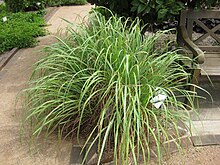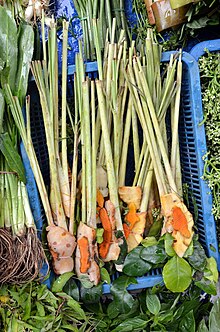Cymbopogon citratus
| Lemon grass | |
|---|---|

| |
| Scientific classification | |
| Kingdom: | Plantae |
| Clade: | Tracheophytes |
| Clade: | Angiosperms |
| Clade: | Monocots |
| Clade: | Commelinids |
| Order: | Poales |
| Family: | Poaceae |
| Subfamily: | Panicoideae |
| Genus: | Cymbopogon |
| Species: | C. citratus
|
| Binomial name | |
| Cymbopogon citratus | |
| Synonyms[2] | |
|
List
| |
Cymbopogon citratus, commonly known as West Indian lemon grass or simply lemon grass,[3] is a tropical plant native to Maritime Southeast Asia and introduced to many tropical regions.[4]
Cymbopogon citratus is often sold in stem form. While it can be grown in warmer temperate regions, such as the UK, it is not hardy to frost.
Morphology
Cymbopogon citratus is part of the grass family, Poaceae. They contain simple, bluish-green leaves with entire margins and are linear in shape. The blades tend to be 18–36 inches long. Like other grasses, the leaves also have parallel venation.[5]
Distribution
Cymbopogon citratus is native to
In its native range, Cymbopogon citratus is known as sereh, serai, or serai dapur in Indonesia and Malaysia; and tanglad (from Proto-Austronesian *Caŋelaj originally referring to Themeda gigantea, a type of elephant grass[7]), salai, or balioko in the Philippines.[6]
Culinary uses


Cymbopogon citratus is abundant in the
The dried leaves can also be brewed into a tea, either alone or as a flavoring in other teas, imparting a flavor reminiscent of lemon juice but with a mild sweetness without significant sourness or tartness.
In Sri Lanka, lemongrass is known as sera (සේර). It is used as a herb in cooking, in addition to its use for the essential oils.[9]
Lemongrass in Thailand is called takhrai (ตะไคร้). It is the essential ingredient of
Medicinal uses
This section needs more primary sources. (December 2015) |  |
The leaves of Cymbopogon citratus have been used in traditional medicine and are often found in herbal supplements and teas. Evidence of effective Cymbopogon citratus essential oil anti-protozoa activity against Leishmania amazonensis.[10]
Chemical composition
Lemon grass oil contains 65–85%
Citronellol is an essential oil constituent from Cymbopogon citratus, Cymbopogon winterianus, and Lippia alba. Citronellol has been shown to lower blood pressure in rats by a direct effect on the vascular smooth muscle leading to vasodilation.[14] In a small, randomized, controlled trial, an infusion made from C. citratus was used as an inexpensive remedy for the treatment of oral thrush in HIV/AIDS patients.[15]
Laboratory studies have shown cytoprotective, antioxidant, and anti-inflammatory properties in vitro.[16][17][18]
Traditional medicinal use
In the
In
Effect on insects

Beekeepers sometimes use lemon grass oil in swarm traps to attract swarms. Lemon grass oil has also been tested for its ability to repel the pestilent stable fly,[21] which bite domestic animals.
See also
References
- ^ "Cymbopogon citratus". Germplasm Resources Information Network. Agricultural Research Service, United States Department of Agriculture. Retrieved 2008-03-02.
- ^ "The Plant List: A Working List of All Plant Species". Retrieved May 8, 2014.
- ^ USDA, NRCS (n.d.). "Cymbopogon citratus". The PLANTS Database (plants.usda.gov). Greensboro, North Carolina: National Plant Data Team. Retrieved January 12, 2019.
- ^ "Cymbopogon citratus". Plants of the World Online. Royal Botanic Gardens, Kew. Retrieved March 4, 2019.
- PMID 22171285.
- ^ a b Oyen, L.P.A. "Cymbopogon citratus (PROSEA)". Pl@ntUse. Retrieved 30 June 2019.
- ^ Blust, Robert; Trussel, Stephen (2010). "*Caŋelaj elephant grass, miscanthus grass: Themeda gigantea". Austronesian Comparative Dictionary. Max Planck Institute for Evolutionary Anthropology. Retrieved 8 November 2022.
- ^ "Tanglad / Lemongrass". Market Manila. August 21, 2006. Retrieved July 27, 2011.
- ^ "The Spice Council of Sri Lanka". www.srilankanspices.com. Archived from the original on 2011-03-23.
- S2CID 22754248.
- S2CID 191177588.
- ISBN 9788189422455.
- ^ Inquirer.net, ‘Tanglad’ goes mainstream, yields essential oils Archived 2008-06-29 at the Wayback Machine
- PMID 20002067.
- PMID 19109001.
- PMID 20438326.
- S2CID 20909743.
- S2CID 9395057.
- PMID 17561386.
- ^ Rodrigues, Eliana & Carlini, E.A. (2006): Plants with possible psychoactive effects used by the Krahô Indians, Brazil. Revista Brasileira de Psiquiatria 28(4): 277-282. PDF fulltext Archived 2020-08-01 at the Wayback Machine
- ^ PMID 23759542.
